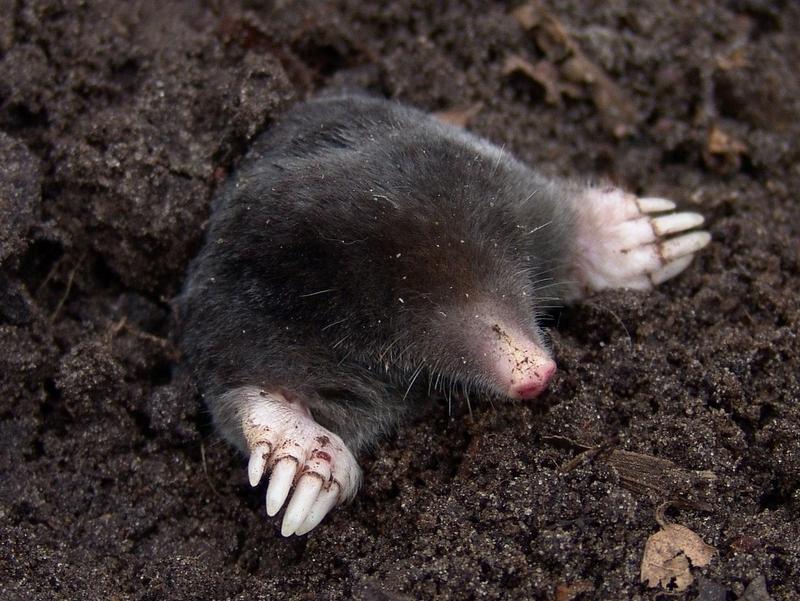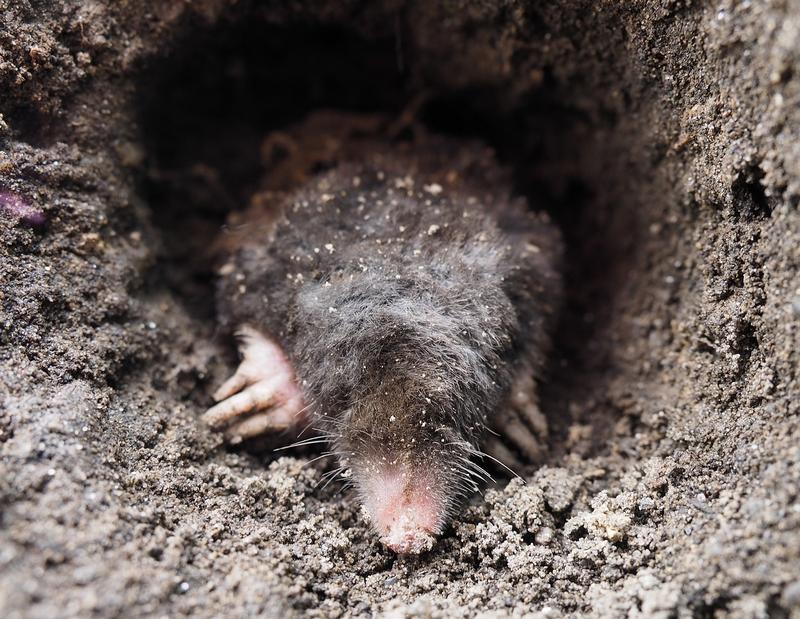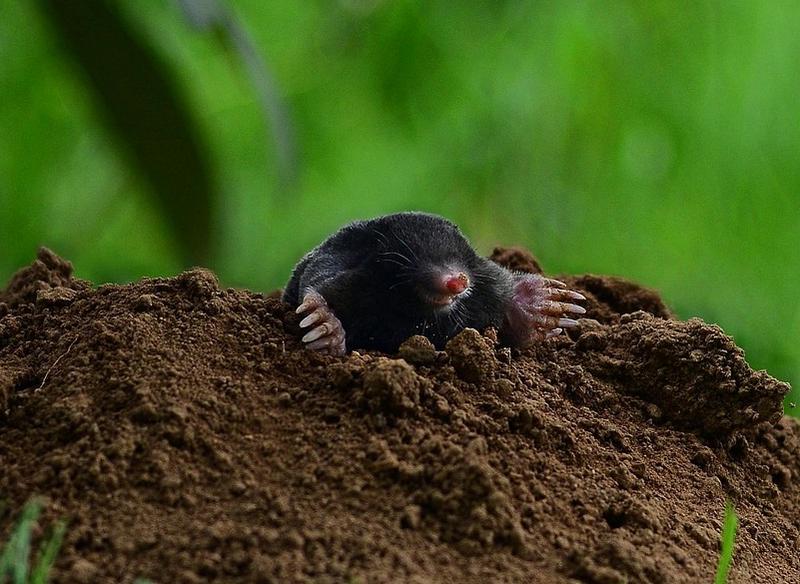Are Moles Poisonous to Dogs? Can Dogs Eat Moles?
Are moles poisonous to dogs? Can dogs eat moles? In this article, we’ll cover everything you need to know on this subject, including what to do right away, and how you can prevent any future problems. And if you were a little too late, we’ll tell you what to do if your dog killed a mole, and if he’ll get sick.
Next, we’ll cover the other side of the problem. That means going over things like do moles attack dogs, are moles dangerous to dogs, can moles bite dogs, the signs of mole poison in dogs, and do moles carry diseases before finally finishing by instructing you on how to get rid of moles in your yard. Keep reading!
Are Moles Poisonous to Dogs?

Moles are not poisonous to dogs. That said, like with any interaction between domestic pets and wild animals, there could be potential risks. Moles, although harmless in terms of toxicity, may carry parasites or diseases that could pose a risk to your pet.
As such, it’s always best to prevent dogs from engaging in any behaviors that could lead to an interaction with a mole, such as digging in mole hills or attempting to catch the mole itself. So while a mole won’t poison your dog, it’s better to avoid any close encounters where possible.
Are Moles Toxic to Dogs?
Moles are not toxic to dogs. They do not produce any poison or venom that could harm your dog if eaten or bitten. Nonetheless, you should know that moles can carry diseases and parasites like fleas, ticks, and various types of worms.
These parasites can transfer to dogs if they come in contact with, catch, or consume a mole. While it’s not the mole itself that poses a risk, these potential carriers of disease they may harbor underline the need to ensure the health and safety of your dog by preventing contact between your dog and moles.
Ground Moles and Dogs
A dog’s instinctual predilection for digging and hunting can often lead to an encounter with a mole in your backyard. Although the moles themselves are unlikely to harm your dog directly, their parasites and the surrounding environment of their burrows could pose health risks.
The soil around mole burrows can harbor other organisms or substances harmful to dogs. Moreover, a dog that becomes obsessive in its quest to dig for moles may inadvertently damage their paws or run the risk of becoming injured by sharp objects concealed in the ground. Watch your dog outdoors closely if you are aware of the presence of moles.
How to Train the Stay Command
Training your dog to stay will help you to stop your dog from chasing moles or other critters. Here’s what to do:
- Begin by choosing a quiet area without distractions and have your dog sit next to you.
- Hold out your hand with your palm facing your dog and say “stay.”
- Take a step back. If your dog remains seated, return to them, offer lots of praise, and give them a treat.
- Repeat this process, gradually increasing the distance and duration of the stay as your dog becomes more comfortable with the command.
- Always remember to reward your dog generously for obeying the stay command. Consistent positive reinforcement will help them learn this command faster and more effectively.
How to Train the “Leave It” Command
The “leave it” command can be incredibly useful in preventing your dog from picking up moles or any small animals you’d rather they stayed clear of. Here’s how to train it:
- Start with a treat in each hand. Show one to your dog and say “leave it.”
- Wait patiently until your dog stops trying to get the treat and instead redirects their attention to you.
- When they do, use a marker word such as “good” or “yes”, and give them the treat from your other hand.
- Practice this command over several sessions, increasing the difficulty gradually by placing the treat on the ground or using more attractive items.
- Over time, your dog will learn that the phrase “leave it” means they are to ignore whatever they’re focused on, and doing so will result in a reward.
These steps will get your dog to stop eating moles and to stay away from them, but it’s important to remember that the underlying behavioral issues (prey drive, curiosity, overexcitement, etc.) that were causing all of this to begin with will still be present. And until you address those, any positive changes you see are only going to be temporary.
“Well, how do I make these changes last?”
By getting your dog to truly choose to follow your direction, that’s how. I tried many times to write out how you can do that before deciding it made more sense to just link you to the free video series that explains it better than I’d ever be able to.
The series is by a man named Dan who is one of the world’s leading dog obedience trainers. In it, he teaches you how to put an end to things like when your dog eats moles and all other misbehavior using his fast and easy-to-follow methods.
In the first video, Dan will reveal to you why the two most common methods of dog training only doom you to failure. You can watch the video now by clicking here. Follow the proven system he’ll show you in his series and you’ll never have to spend another second worrying about your dog killing moles or anything else ever again!
Can Dogs Eat Moles?

Dogs cannot eat moles. Moles are not inherently toxic, but they can carry parasites and diseases, potentially causing harm to your dog. If your dog has eaten a mole, monitor them for any signs of illness, and consult your vet if necessary.
My Dog Ate a Mole: What Should I Do?
If your dog ate a mole, don’t panic, but be observant. While it’s not ideal, dogs are opportunistic eaters and can handle a variety of foods. However, the parasites and diseases moles may carry require vigilance. Watch for gastrointestinal upset symptoms like vomiting, diarrhea, or reduced appetite.
Potential Risks to Dogs Eating Moles
Beyond immediate digestive upset, moles can pose additional risks to your dog. Moles can be hosts to parasites such as ticks, fleas, or worms, which can then be passed on to your pet. If left untreated, these parasites can cause health complications ranging from skin issues to more severe internal problems.
Preventing Dogs from Eating Moles
Prevention is always better than cure. To discourage your dog from eating moles, you can use training commands such as “leave it” or “stay”. These commands can be crucial in stopping your dog from eating or chasing something they shouldn’t (learn both in the first section). Additionally, managing their environment to minimize encounters with moles can also be helpful.
When to Consult a Veterinarian
If you notice symptoms of illness after your dog ate a mole, or if your dog regularly catches and eats moles, it’s a good idea to consult a veterinarian. They can check for parasites and provide treatment if necessary. For help on the commands that will keep your dog away from moles in the future, go back to the first section.
It will be a very good idea to get this issue with your dog taken care of now, as it will also help them in other future interactions. You then won’t have to worry about things like groundhogs being dangerous to dogs, beavers attacking dogs, voles being dangerous to dogs, gophers being dangerous to dogs, or your dog killing possums.
My Dog Killed a Mole, Will He Get Sick?

A dog that kills a mole will not get sick in most cases. However, if your dog consumes the mole or comes into contact with the mole’s bodily fluids, there is a risk of parasite transmission or disease. Therefore, it’s important that you keep an eye on your pet for any signs of illness following such an incident and consult a vet if needed.
My Dog Killed a Mole: What Now?
If your dog killed a mole, the first thing to do is prevent them from eating it if possible. Check them for any signs of injury from the encounter, and remove any visible ticks or fleas that could have been transferred from the mole.
Potential Risks from Killing Moles
Even if your dog doesn’t eat the mole, there could be some risks involved. Moles can host ticks, fleas, and worms, which could be transmitted to your dog during the act of killing the mole. Additionally, any potential diseases the mole could be carrying may pose a risk.
Preventive Measures to Stop Dogs from Killing Moles
Preventive measures include training your dog to follow commands like “leave it” or “stay” and managing the mole population in your yard. This can help reduce the chance of your dog coming into contact with moles. We explain how to do both in the first section.
Monitoring Your Dog After the Incident
After your dog has killed a mole, observe them closely for signs of illness or discomfort. This could include changes in behavior, appetite, or physical symptoms like vomiting, diarrhea, excessive scratching, or unusual lethargy.
When to Visit the Vet
If your dog shows signs of illness following an encounter with a mole, or if they have regular contact with moles, consult a vet. The vet can check for signs of parasites or disease and provide any necessary treatment. For the prevention strategies you’ll need, go back to the first section now.
Do Moles Attack Dogs?

Moles do not attack dogs in most cases. They are generally non-aggressive creatures that prefer to stay underground, avoiding contact with potential predators or threats, including dogs. However, if a mole is cornered or feels threatened, it may try to defend itself which can include biting.
Are Moles Dangerous to Dogs?
Moles are not dangerous to dogs. They are not known to carry diseases themselves that can be transmitted to dogs. However, like any wild animal, a mole can potentially harbor parasites, such as fleas or ticks, which could pose a risk to dogs.
Furthermore, if a dog caught a mole and has injured it, the mole might bite or scratch in self-defense, potentially leading to minor wounds. Their primary defense mechanism is their ability to quickly retreat underground.
Can Moles Bite Dogs?
Moles can bite dogs, although it is relatively uncommon. Moles are equipped with sharp teeth that are primarily used for digging and capturing small invertebrates for food. However, if they feel threatened and are unable to escape, they may use these teeth in an attempt to defend themselves.
Mole Bite on Dog: What Do They Look Like?
Identifying a mole bite on a dog can be challenging. The bite marks are often quite small and may not bleed excessively. They usually present as small puncture wounds and are most likely to be found on the dog’s face or paws, as these are the parts of the body that dogs typically use to investigate or catch moles.
If your dog has unexplained wounds, particularly after being outdoors or showing interest in a molehill, it’s advisable to consult with a veterinarian to ensure appropriate treatment and prevent potential infections.
Preventing Mole Encounters with Dogs
The best way to prevent mole encounters with dogs is by controlling the mole population in your yard and supervising your pet while they’re outside. Additionally, training your dog to obey commands like “leave it” or “stay” can help pull them away from a potential mole encounter. We explain how to do both in the first section.
When to Consult a Veterinarian
If your dog has been bitten by a mole, it’s always a good idea to consult a vet, even if the wound seems minor. This can help prevent potential infections and ensure your pet’s overall health and well-being.
Signs of Mole Poison in Dogs

If a dog ate mole poison or has ingested a poisoned mole, it can result in serious health problems. Immediate veterinary attention is crucial if you suspect your dog has consumed mole poison. Symptoms can include weakness, lethargy, loss of appetite, bruising, bleeding, and in severe cases, seizures or even death.
Dog Ate Mole Poison
Mole poison often contains toxic substances like bromethalin, warfarin, or zinc phosphide which can be extremely harmful or even fatal to dogs. If a dog eats mole poison, symptoms may vary based on the specific toxin involved.
Bromethalin, a potent neurotoxin, can lead to symptoms such as unsteadiness, muscle tremors, seizures, and paralysis.
Warfarin-based poisons, also known as anticoagulants, prevent the blood from clotting and can result in internal bleeding. Signs can include lethargy, blood in vomit or feces, nosebleeds, and excessive bruising.
Zinc phosphide can cause vomiting, difficulty breathing, tremors, and in severe cases, failure of multiple organs.
What Happens if a Dog Eats a Poisoned Mole?
If a dog eats a poisoned mole, they may experience secondary poisoning. The specific symptoms can depend on the type of poison that the mole ingested, but generally, you may notice signs of distress in your dog such as loss of appetite, vomiting, diarrhea, difficulty breathing, or abnormal behavior.
What to Do if You Suspect Your Dog Has Ingested Mole Poison?
If you suspect your dog has ingested mole poison, it’s important to seek immediate veterinary attention. Do not induce vomiting unless specifically instructed to do so by a veterinarian, as some poisons can cause more damage when vomited.
If possible, bring the packaging of the poison or a sample of the mole with you to the veterinarian. This can help your vet to quickly identify the type of poison involved and provide appropriate treatment.
Preventing Exposure to Mole Poison
To prevent your dog from being exposed to mole poison, you should not use these products in any areas where your dog has access. Opt for pet-friendly pest control alternatives and ensure your dog is supervised while outside, especially in areas known to have moles. Regularly inspect your yard for any mole activity and remove your dog from the area if necessary.
Learn two easy commands that will help control your dog’s behavior by going back to the first section.
Do Moles Carry Diseases?
While moles are not typically carriers of diseases that are harmful to humans or pets, there are some potential risks. It is uncommon, but not impossible, for moles to carry rabies or parasites which could potentially be passed to dogs. The most important precaution to take is to prevent your pet from hunting or eating moles.
Do Moles Carry Rabies?
Moles are not common carriers of rabies. However, any mammal can theoretically contract and transmit the virus. It is always best to avoid direct contact with wild animals like moles and discourage your pets from interacting with them. If your pet has been bitten by a mole, seek immediate veterinary care.
Can Moles Carry Parasites?
Moles may host a variety of parasites like fleas, ticks, or mites. If your dog catches and interacts with a mole, there is a chance these parasites could transfer. Parasites may carry diseases like Lyme disease, which can affect both humans and dogs. Regularly check your pet for signs of fleas and ticks, especially after spending time outdoors.
Preventing Contact with Moles
The best way to protect your dog from potential diseases or parasites that could be carried by moles is to prevent contact altogether. Train your dog to avoid molehills and burrows in your yard. If your dog does catch a mole, do not allow them to eat it. Consult a veterinarian if you suspect your dog has been in contact with a mole, especially if they show signs of illness.
Learn two commands that will help you control your dog around moles (and other critters) by going back to the first section now.
Mole Activity in Your Yard
If you notice mole activity in your yard, consider humane ways to discourage them, such as natural repellents or barriers. This will not only protect your lawn but also prevent your pets from encountering these animals. Consulting with a pest control professional can provide further guidance on managing mole activity safely and effectively.
How to Get Rid of Moles in Your Yard
To get rid your yard of moles, a combination of natural repellents, physical barriers, mole traps, and possibly professional removal is required. Remember, you must only use methods that are safe for dogs and other pets.
- Natural Repellents: Many natural substances, such as castor oil and garlic, can be used to deter moles. Spreading these substances throughout your yard, especially near molehills and tunnels, can discourage moles from burrowing and prompt them to seek a less irritating environment.
- Physical Barriers: Installing physical barriers, such as underground fencing or mesh, can prevent moles from burrowing into your yard. The barrier should reach a few feet underground and extend above the surface to discourage moles from burrowing beneath or climbing over it.
- Mole Traps: Traps can be effective if properly installed near active mole tunnels. However, they should be used cautiously as they can be harmful to pets or non-target wildlife. Always follow the manufacturer’s instructions and consider covering the traps to keep pets away.
- Professional Removal: If the mole problem persists, it may be necessary to hire a professional pest removal service. They have the necessary experience and equipment to handle mole infestations safely and efficiently.
Getting rid of moles involves the use of natural repellents, installation of physical barriers, strategic use of mole traps, and potentially professional assistance. Always choose methods that are safe for your pets and other wildlife in your yard. Learn to control your dog’s behavior around moles by going back to the first section.
I’m sure you’re ready to not worry about anymore issues between ground moles and dogs, so I’ll let you get started on all of this now. Good luck, and thanks for reading our article “Are Moles Poisonous to Dogs? Can Dogs Eat Moles?”





